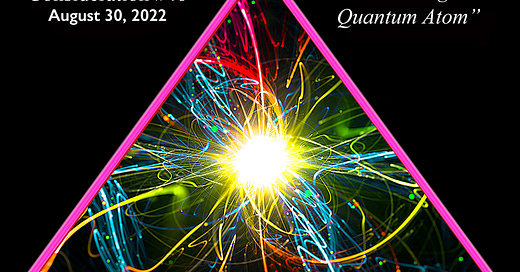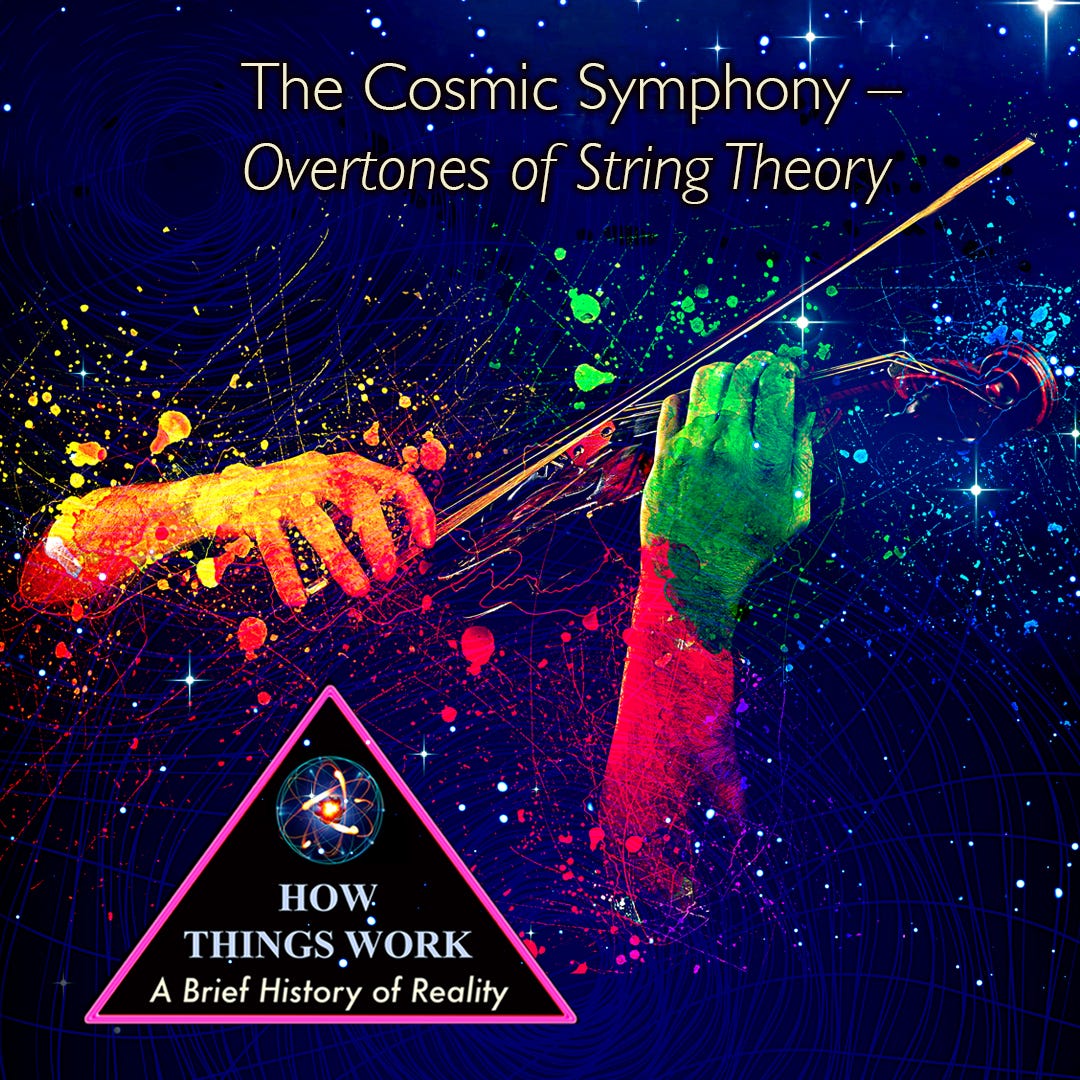How Things Work: A Brief History of Reality
Book II: The Power of Three (#46 – "Abstracting the Quantum Atom")
Be A Part of the Conversation!
Tuesday, August 30, 2022
“It is a slightly arresting notion that if you were to pick yourself apart with tweezers, one atom at a time, you would produce a mound of fine atomic dust, none of which had ever been alive but all of which had once been you.”
― Bill Bryson (A Short History of Nearly Everything)
CONSIDERATION #46 – Abstracting the Quantum Atom
PREFACE
Welcome Everybody!
As the mystery of the atom continued to be revealed the focus of attention turned to the concept of light. In 1918, Max Planck discovered “energy quanta,” establishing a new blueprint for how the world of the atom really worked. He argued that light at the quantum level did not act as a continuous wave, but as discrete energy packets of light. This set the stage for the future of both Relativity Theory and Quantum Mechanics and initiated one of the main paradoxes resulting from the two competing theories: wave particle duality. Ironically, objective experiments designed to establish the wave-like quality of light demonstrated the wave-like quality of light; however, experiments designed to establish the particle-like quality of light demonstrated the particle-like quality of light. Light could not physically be both a particle and a wave at the same time.
“Planck’s work would become the mathematical foundation for the new field of Quantum Mechanics which was now developing revolutionary avant-garde theories regarding the sub-atomic world of reality.”
Albert Einstein would use Planck’s work to develop his theories related to the speed of light and redefine Planck’s “energy quanta” into what we now know as a “photon.” Planck’s work would become the mathematical foundation for the new field of Quantum Mechanics which was now developing revolutionary avant-garde theories regarding the sub-atomic world of reality. From this point on, modern science would desperately attempt to find a theory of Reality that would work consistently in both the world of the atom and the world of the physical objects manifested by them.
“More and more, science would rely on purely mathematical abstractions to describe the chaos and incompatibility found to exist between the universe and its constituents.”
With the amazing revelations generated from Special Relativity, General Relativity, and Quantum Mechanics, the objective empirical foundation of science began to crack. More and more, science would rely on purely mathematical abstractions to describe the chaos and incompatibility found to exist between the universe and its constituents. Eventually, the two theories would attempt to merge into a complete mathematical abstraction or “theory of everything” known as String Theory. However, it all starts in 1918 with Max Plank’s discovery of “energy quanta.”
CONSIDERATION #46 – Abstracting the Quantum Atom
“If quantum mechanics hasn’t profoundly shocked you, you haven’t understood it yet”.
– Niels Bohr
The Quantum Atom
Once the atom was found to be divisible, the foundational certainty of classical physics began to diminish dramatically and quickly. Despite the amazing practical results obtained by classical scientific approaches, the newly discovered atomic constituents seemed to play by a different set of rules than larger objects in the real world. A new science was developed to solve these discrepancies utilizing a completely new set of laws called “quantum mechanics,” or “wave mechanics,” that would fundamentally change the way we viewed the world. However, a somewhat impractical science in that it was completely theoretical, it needed traditional classical principles to be fully exploited:
Put simply, it’s the physics that explains how everything works: the best description we have of the nature of the particles that make up matter and the forces with which they interact… Quantum physics underlies how atoms work, and so why chemistry and biology work as they do... at some level at least, we’re all dancing to the quantum tune. If you want to explain how electrons move through a computer chip, how photons of light get turned to electrical current in a solar panel or amplify themselves in a laser, or even just how the sun keeps burning, you’ll need to use quantum physics… But to understand how things work in the real world, quantum mechanics must be combined with other elements of physics – principally, Albert Einstein’s special theory of relativity, which explains what happens when things move very fast – to create what are known as quantum field theories.
Richard Webb – New Scientist
Eventually, Niels Bohr would become the first modern scientist to utilize these new quantum theories in describing the submicroscopic world of the atom. However, it begins in 1918, when Max Planck won the Nobel Prize in Chemistry for his discovery of energy quanta, leading to a new branch of non-classical physics utilizing the principles of quantum mechanics. According to Planck’s Quantum Theory:
Different atoms and molecules can emit or absorb energy in discrete quantities only. The smallest amount of energy that can be emitted or absorbed in the form of electromagnetic radiation is known as quantum.
Planck’s theory was not so much a formal assumption applicable to physics as it was a fundamental new discovery related to the nature of light itself. In essence, Planck found that light was not emitted as a “continuous” wave but as small discrete energy packets, called quanta. Later, Albert Einstein corroborated Planck’s theory, redefining these discrete energy packets of light as “photons,” winning him the Nobel Prize in Physics in 1921. Planck’s experiments represented the birth of quantum mechanics.
This theory led to Planck’s Constant, establishing the relationship between a photon’s energy and its frequency:
The energy of the radiation absorbed or emitted is directly proportional to the frequency of the radiation.
The mystery of light had been decoded. This physical constant essentially defines the divisibility of the quantum world. In fact, this constant appears in virtually all equations related to quantum phenomena.
Ironically, the indivisible atom of classical physics had been replaced by the new indivisible photon of quantum mechanics. The photon now represented the smallest indivisible and indestructible unit of matter. The emission of photons provides a spectral color range that can identify the make-up of virtually any matter based on its absorption and radiation of heat. Visible ranges of color include red, orange, yellow, green, cyan, blue, and violet. It also contains non-visible light in the ultraviolet range.
“The fact that our sun is ‘yellow’ means it is ‘less hot’ (lower frequencies) than a sun that is in the blue range (higher frequencies), meaning they are made up of different atoms…”
Lower range frequencies are seen as red, orange, and yellow, whereas higher range frequencies are seen as green, blue, and violet. The even higher ultraviolet spectrum is not visible to the human eye at all. This colored light is directly related to the electron’s orbital energy and the emission and absorption of photons in the atoms making up that particular physical thing. The fact that our sun is “yellow” means it is “less hot” (lower frequencies) than a sun that is in the blue range (higher frequencies), meaning they are made up of different atoms; essentially allowing us to determine its composition, or atomic structure, by its radiated color. This is how infrared and ultraviolet photography work. Color is based on the frequency of the atom’s photons.
“…using Planck’s laws of quantum mechanics, Niels Bohr suggested that electrons were located at specific fixed distances from the nucleus of an atom based on specific energy levels.”
Niels Bohr realized that certain problems with the Planetary Model of the atom could never be reconciled with traditional classical physics. Bohr understood that classical physics could never fully explain the incredibly small world of the atom; making problems such as why electrons didn’t crash into the nucleus of the atom an impossible question to answer adequately within its own inherent limitations. However, using Planck’s laws of quantum mechanics, Niels Bohr suggested that electrons were located at specific fixed distances from the nucleus of an atom based on specific energy levels. Bohr explained that electrons tend to seek the lowest energy level available and fill that level first. However, electrons can move, or “jump,” from one energy level, or state, to another. This jump releases a specific, measurable amount of energy, or quanta.
“When filling orbits, electrons fill the lower energy levels first.”
According to Bohr, electrons orbit the nucleus of an atom in orbits that have a specific size and energy. The lower the energy of the electron, the lower, or closest to the nucleus, the orbit will be. When filling orbits, electrons fill the lower energy levels first. If an energy level, or orbit, is full, a new higher energy level will be created. Radiation, in the form of photons, is released and absorbed when electrons move from one energy level to another.
“…the infinitely small world of atoms was not held in place by classical principles such as gravity and motion, but through a series of energy levels that maintained their connection with the nucleus…”
Unlike the large world of planets and suns, the infinitely small world of atoms was not held in place by classical principles such as gravity and motion, but through a series of energy levels that maintained their connection with the nucleus based on the orbits that were filled or available. The behavior of atoms is based on this quantum phenomenon. However, although closer to the “truth,” Bohr’s model of the quantum atom was based on the single, and simplest atom, Hydrogen. Bohr’s theory needed some slight adjustments to make it compatible with other atoms.
POSTSCRIPT
The central focus of physics shifts to a consideration regarding the nature of light and what that means at the quantum and universal level of understanding reality. In “classical physics” it would lead to Einstein’s Special Theory of Relativity. In the new abstract science of Quantum Mechanics, it would eventually lead to String Theory.
“How can you scientifically prove something that is inherently uncertain?”
In the field of Quantum Mechanics, the focus of science shifts from certainty to probability. In the quantum world, virtually nothing is certain. This is problematic for a field of study (science) based on utilizing objective certainty to expand objective certainty. How can you scientifically prove something that is inherently uncertain? The paradoxes generated from Einstein’s theories of the universe and Quantum theories related to the atoms that composed it continue to haunt science to the present day. What science was about to discover was that there was nothing certain about science at all.
Next week we consider the nature of probability within the Quantum world. Schrodinger will redefine the quantum atom and eventually question the probability of live or dead cats. The once indivisible, indestructible atom transforms into a nebulous cloud of electrically charged possibility and probability with no complete certainty or predictability any longer possible.
Part of the “Reality by a Thread” Upgrade – CLICK IMAGE to learn more!
Excerpt from Untangling the Knots of Reality – Podcast #12: “Untangling Happiness & Virtues"
Upgrade Now!
Coming September 22: BOOK IV “The Cosmic Symphony – Overtones of String Theory.” FREE PDF DOWNLOAD for PAID SUBSCRIBERS – 20% OFF FOR FREE SUBSCRIBERS!
CLICK IMAGE to Learn More…
Catch Up on the Conversation! CLICK IMAGE to Learn More!
Get Ahead of the Conversation! CLICK IMAGE to Learn More!








